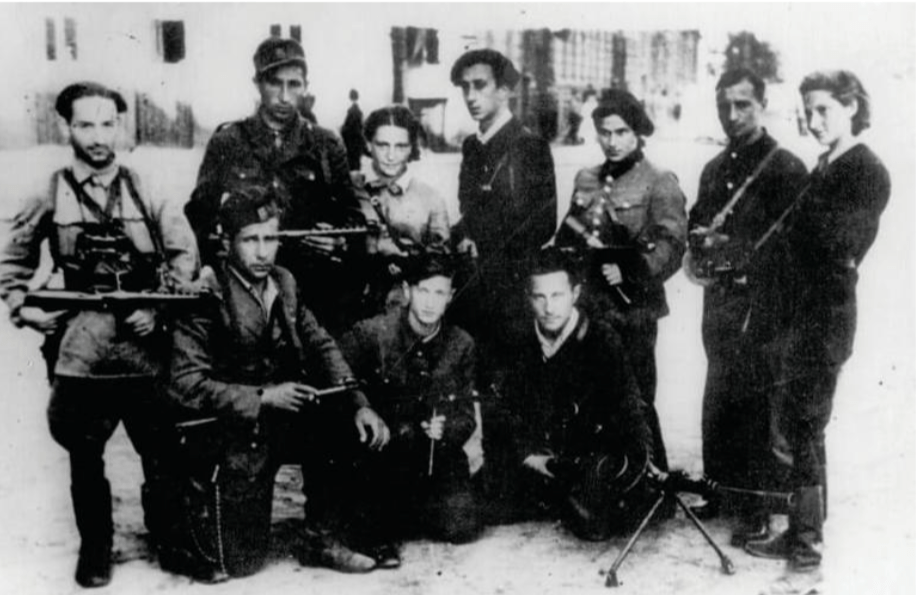Remembering Jewish Resistance
The United Nations General Assembly, in a November 2007 vote on Resolution 60/7, established January 27 as its official worldwide Holocaust Remembrance Day. It honors the memory of Holocaust victims, “one-third of the Jewish people, along with countless members of other minorities.” As a matter of historical record, Jews, Roma, members of the LGBTQ+ community, and those deemed either mentally or physically “unfit” all were murdered.
According to historian Yehuda Bauer in Rethinking the Holocaust, abstract ideology motivated its perpetrators, rather than the “pragmatic” concerns “central with all other genocides.” (They keep the camps running with men and materials they needed elsewhere.) Second, it was “global” in scale rather than geographically limited. (Mr. Bauer cites Turkish indifference to Armenians in Jerusalem as a counter-example.) Third, the Nazis intended to round up and eradicate Jews of every age and description, without exception. It was the very targeted industrial murder of people that made this genocide, unlike all those genocides before and after it, a “Holocaust.”
January 27 is the anniversary of the liberation of the Auschwitz concentration camp by the Soviet Union’s Army. The vast role the Soviet Union played in defeating the Nazi monster is not usually remembered in the West. North Americans usually think of D-Day, June 6, 1944, as the turning point in World War II. It certainly was one juncture of importance as it opened up a second front in Europe. Before that, in May 1943, the United States and the British Empire defeated German and Italian armies in North Africa. Churchill named that victory “the end of the beginning.” It was the Battle of Stalingrad, however, from August 1942 through February 1943, when the Soviet Union defeated Germany and its Axis partners, that changed the war. The Soviet Army, pushing eastward, liberated the Auschwitz camp in January 1945.
Neither the Soviet Union nor the United States, despite repeated entreaties, bombed the rail lines that fed Jews and others into the concentration camp system.
The United Nations intended Holocaust Remembrance Day as a time when we should memorialize the victims, fight against Holocaust denial, and educate future generations about what happened. It is in that spirit, on this January 27, a Jewish sabbath, I would like to devote the rest of this article to Jewish resistance to the Nazi killing machine.
I know from talking with survivors that the only reason they were still alive is their own quiet determination to resist and through lying (often pretending not to be Jewish), deception, fast legs (as in running away from a camp), and blind luck.
In the late 1970s, while I was still welding beer truck frames, I read They Fought Back, edited by Yuri Suhl, an anthology of Jewish resistance.
I read about Niuta Teitelbaum, codename “Wanda,” a 24-year-old, “Aryan looking” blond-haired Jewish woman who lived in the Warsaw Ghetto. She ran communications and goods between the ghetto and the Polish outside, shot German officers point blank, joined the partisans in the forest, and helped destroy one of their bigger guns. In 1943, she was eventually caught by the Gestapo and was killed. But she never broke.
Suhl also wrote about Rosa Robota, a young Jewish girl working in Auschwitz II, Birkenau. At home in her Polish hometown, she had been a member of Hashomer Hatzair, the secular Labor Zionist organization. She became part of a bomb-making-smuggling operation that eventually blew up one of the four crematoria in the camp. It also killed four Nazis and led to a mass escape of 600 souls. She was captured by the Gestapo and brutalized. Nonetheless, she sent out the message “Be Strong and Brave” before she was hung.
Suhl commented that “in practically every ghetto and in every labor and concentration camp, there existed a Jewish underground organization that kept up prisoners’ morale, reduced their physical suffering, committed of sabotage, organized escapes, collected arms, planned revolts, and, in many instances, carried them out.”In thirty chapters, he or his co-authors described these revolts.
Chief among them is the Warsaw Ghetto Uprising. I have read a number of books on this revolt, including Notes from the Warsaw Ghetto by Emmanuel Ringelblum. He lived and died in the Ghetto, and it is because of his daily notes and archives that we know so much about life in that ghetto. There are also a couple of chapters in Suhl’s book on Warsaw, including one entitled “Comrade Mordecai,” by Ringelblum, describing the Hashomer Hatzair member who became the commander of the 600-member strong Jewish Fighters Organization.
There were two fighters’ organizations in the ghetto; the second, a smaller group was associated with the Revisionist Jews. Once the fighting began, many other families made bombs, threw them at the Nazi soldiers, and shot at them as well.
The date of the Uprising is usually given as April 19 to May 16, 1943, almost four full weeks of fighting. I would like to offer different dates. Fighting actually began on January 18, when the German military tried to enter the camp to expel Jews to concentration camps and death. Fighting broke out again on April 19, 1943, when the Nazis tried once again to enter the camp. They were pushed back and fighting see-sawed after that. No one ever formally surrendered, and there were Jews hunkered down among the ruins until August 1944, when the general Polish population of Warsaw rose up.
By my count, the Jews of Warsaw fought longer and harder than the Polish Army did in the 35 days they defended their country in 1939.
There are many other stories to tell and other books to read. Including Defiance, the story of an armed camp of Jews who lived in the forests and survived. Recently, The Light of Days tells the story of resistance by women. Memorializing those who fought back should be part of every Holocaust Remembrance Day.



